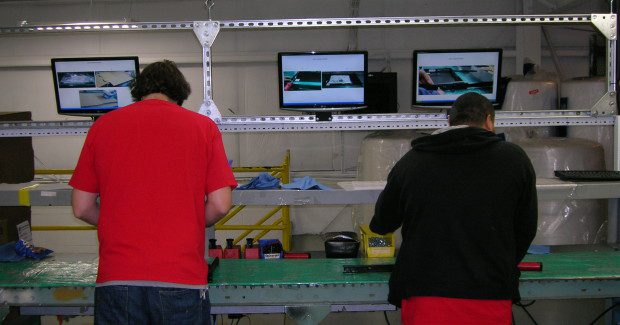How Fabricators Can Foster Real Growth
Guest columnist Jerry Ward of Metcam shares some insights that can help you grow your output, your bottom line and your employee count.
Posted: October 24, 2013
Metcam, Inc.
"Start small by identifying the problem areas in your operation and then picking the low-hanging fruit. Improvements that provide 100 percent payback in 6-12 months will encourage staff and management to keep going."
In the past year or two, there has been much discussion about the “rebirth” of U.S. manufacturing. Much of it is less than optimistic, suggesting that the current growth might be an anomaly and pointing out negative factors that could keep U.S. manufacturing from a real renaissance. During that time, my company and others have been quietly, but persistently, making improvements and engineering innovations that are resulting in substantial growth, and I am hopeful that this trajectory is not a blip on the radar.
Admittedly, the growth of U.S. manufacturing is far from impressive at this point. The U.S. manufacturing sector shed six million jobs between 2000 and 2009 (half the past decade’s unemployment increase among men without college degrees, per economists at the University of Chicago). Since the end of the “Great Recession,” the U.S. manufacturing industry has added only 500,000 jobs, of which 50,000 came from overseas firms moving here (per the Bureau of Labor Statistics).
Nevertheless, during this period, automation and innovation have become increasingly powerful forces and new developments continue to accelerate manufacturers’ ability to accomplish more output. To leverage these advances — and achieve growth in both revenue and employee count, metal fabricators must step away from the mindset of traditional, bloat-and-waste-filled manufacturing methods and reengineer their processes and approaches.
For more than a decade, our company has strived to be at the forefront of technological change, constantly reengineering our operations for excellence. We evaluate every innovative idea for its potential to reduce waste, improve quality and sustainability, increase production agility and flexibility, and add value for the customer. Not all of our improvements meet all these criteria, but most of them do.
Here is a snapshot of some of Metcam’s operations.
In making these improvements, we have been able to achieve record-breaking sales growth, including a 15 percent increase year-over-year in 2012. I’d like to share some of the improvements that have given us these amazing rewards. Any job shop or metal service center can implement these ideas, fostering the excellence and innovation that attracts customers and keeps them coming back.
PUT EVERYONE IN CHARGE OF QUALITY
A few years back, we began training equipment operators as quality inspectors. Now, after running the first part of a job, the operator inspects his work, and then the next operator on the line, who is also qualified to inspect the part, checks it and signs off on it. As work continues, the second operator remains vigilant for defects such as burrs. If he sees an issue, he notifies the previous operator and the defect can be corrected.
Because we currently run a small-cell production setup, operators are adjacent to each other, enabling instant communication of issues. This approach replicates throughout the production process, with each subsequent operator backing up the one before him. This improvement reduced our defect rate to nearly zero.
MAKE IT VISUAL
For many of our lines, we have implemented video-visual work instructions — full-color, digitized images of an operation, with critical points clearly marked — that display on a monitor at each station on the production line. Each worker sees only his or her particular step in the production process. This approach offers several major benefits:
• Reduces translation issues for non-English-speaking workers.
• Enables workers to perform a variety of operations with little to no training.
• Speeds the time to update instructions for fast-breaking design changes.
• Increases line flexibility and minimizes setup time for new production runs. (Some of our lines produce more than 30 different, small-batch items.)
When we implemented this solution on an eight-operator line running a fiber-optic tray assembly, it reduced line errors by 86 percent. We are now in the process of plant-wide implementation.
DRAW IT YOURSELF
A similar, but much less expensive, solution is to create your own in-house drawings. We have noticed that customer drawings were sometimes confusing, cluttered or not clearly marked. Furthermore, they used different design approaches and drawing standards.
We began recreating customer instructions, focusing on simplicity and using a unified design and drawing standard. We also eliminated any notations or instructions not necessary for completion of the process. To ensure quality control, we used the customer’s drawings (and not ours) for quality inspections. Before implementing this improvement, our shop was experiencing significant bottlenecks at the press brake. This one change produced a 20 percent throughput improvement.
INCREASE ACCURACY
One of the smallest, significant improvements we made was to purchase pinpoint-accurate scales to weigh the hardware bags we create for assembly workers to use. The bags contain third-party materials such as screws. If these parts are defective, the defect rate on completed items made with our components can soar.
The scale enabled us to obtain weights so accurate that we could identify defects as small as an improperly stamped screw head or an incorrectly threaded screw—defects that a human could not feel and sometimes could not even see. Since adopting this approach, we have shipped more than 300,000 hardware bags with zero defects.
GIVE THE CUSTOMER EVERYTHING
Until now, we’ve discussed mainly quality or sustainability (lean) improvements. I mentioned adding value earlier, so I’ll close, not with a specific process, but with an approach that achieves this goal. Customers want to work with companies that make their lives simpler and/or save them money and headaches. Our company has done this by offering a variety of add-on services to our customers:
• Performing end-to-end production and assembly. We now produce finished items for customers, even though we fabricate only a few of the components.
• Warehousing other vendor’s parts or components for a customer. This saves them warehouse and shipping space and lets us assemble their items as needed.
• Streamlining and managing logistics. One example is shipping items directly to our client-company’s customers (with a label that reflects the client’s name, not ours).
• Providing just-in-time delivery of finished products. (Don’t commit to this until you have fine-tuned your production processes.)
• Producing on consignment. In some scenarios, our customer doesn’t pay for items we produce until he sells — and we ship — them.
If warehousing and logistics aren’t your strong suit, you have other options. A recent report from MIT suggested that manufacturers could enter the service industry as a way of adding value and increasing revenue. For example, if you have deep expertise designing and fabricating engine components, you could become a technical consultant to firms that install or build engines.
CHALLENGE FOR THE FUTURE
I hope these insights inspire you to foster excellence and improvement in your own operations. These and other improvements you will devise should enable you to grow your output, your bottom line and your employee count. If you are just getting started and don’t know where to begin, I encourage you to start small — identify the problem areas in your operation and then pick the low-hanging fruit. Improvements that provide 100 percent payback in 6-12 months will encourage staff and management to keep going.
Perhaps your shop has already taken steps to optimize its processes and add value to its products. If so, kudos to you, but don’t rest on your laurels. Excellence in metalworking isn’t something you accomplish — it’s an ongoing process.
Quality, lean manufacturing, agility and value enhancement — all the hallmarks of superior operations that can compete successfully in a global marketplace — require continuous attention and focus. The world is changing so dramatically and rapidly that any manufacturer who achieves a pinnacle and sits there will be quickly left behind.
Metcam is a fabricator of precision sheet metal components and assemblies for original equipment manufacturers (OEMs) representing a wide variety of industries. Jerry Ward is a member of the Fabricators and Manufacturers Association (FMA; Rockford, IL) and serves as a periodic speaker and member of the FMA Precision Sheet Metal Technology Council. He is listed in the FMA’s “Who’s Who in Metal Forming.”


















